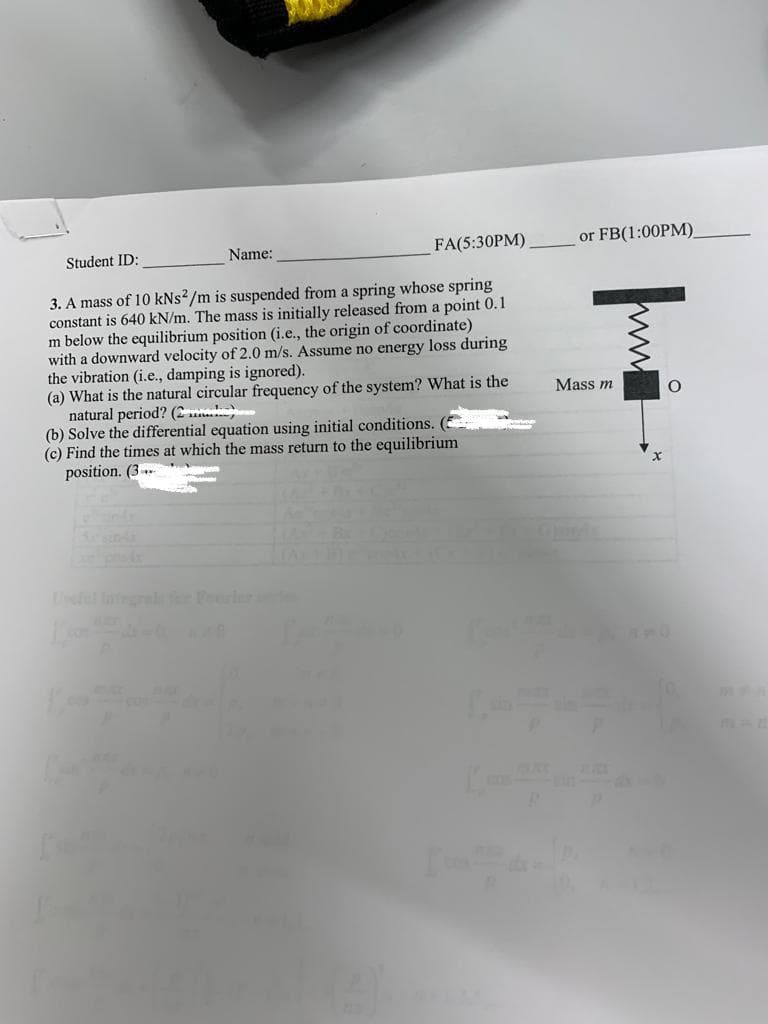3. A mass of 10 kNs2/m is suspended constant is 640 kN/m. The mass is initially released from a point 0.1 m below the equilibrium position (i.e., the origin of coordinate) with a downward velocity of 2.0 m/s. Assume no energy loss during the vibration (i.e., damping is ignored). (a) What is the natural circular frequency of the system? What is the natural period? (2) (b) Solve the differential equation using initial conditions. (c) Find the times at which the mass return to the equilibrium position. (3 Mass m X
3. A mass of 10 kNs2/m is suspended constant is 640 kN/m. The mass is initially released from a point 0.1 m below the equilibrium position (i.e., the origin of coordinate) with a downward velocity of 2.0 m/s. Assume no energy loss during the vibration (i.e., damping is ignored). (a) What is the natural circular frequency of the system? What is the natural period? (2) (b) Solve the differential equation using initial conditions. (c) Find the times at which the mass return to the equilibrium position. (3 Mass m X
Elements Of Electromagnetics
7th Edition
ISBN:9780190698614
Author:Sadiku, Matthew N. O.
Publisher:Sadiku, Matthew N. O.
ChapterMA: Math Assessment
Section: Chapter Questions
Problem 1.1MA
Related questions
Question

Transcribed Image Text:FA(5:30PM)
3. A mass of 10 kNs2/m is suspended from a spring whose spring
constant is 640 kN/m. The mass is initially released from a point 0.1
m below the equilibrium position (i.e., the origin of coordinate)
with a downward velocity of 2.0 m/s. Assume no energy loss during
the vibration (i.e., damping is ignored).
(a) What is the natural circular frequency of the system? What is the
natural period? (2)
(b) Solve the differential equation using initial conditions.
(c) Find the times at which the mass return to the equilibrium
position. (3
Student ID:
Name:
or FB(1:00PM)
Mass m
JA
O
Expert Solution
This question has been solved!
Explore an expertly crafted, step-by-step solution for a thorough understanding of key concepts.
Step by step
Solved in 2 steps

Knowledge Booster
Learn more about
Need a deep-dive on the concept behind this application? Look no further. Learn more about this topic, mechanical-engineering and related others by exploring similar questions and additional content below.Recommended textbooks for you

Elements Of Electromagnetics
Mechanical Engineering
ISBN:
9780190698614
Author:
Sadiku, Matthew N. O.
Publisher:
Oxford University Press

Mechanics of Materials (10th Edition)
Mechanical Engineering
ISBN:
9780134319650
Author:
Russell C. Hibbeler
Publisher:
PEARSON

Thermodynamics: An Engineering Approach
Mechanical Engineering
ISBN:
9781259822674
Author:
Yunus A. Cengel Dr., Michael A. Boles
Publisher:
McGraw-Hill Education

Elements Of Electromagnetics
Mechanical Engineering
ISBN:
9780190698614
Author:
Sadiku, Matthew N. O.
Publisher:
Oxford University Press

Mechanics of Materials (10th Edition)
Mechanical Engineering
ISBN:
9780134319650
Author:
Russell C. Hibbeler
Publisher:
PEARSON

Thermodynamics: An Engineering Approach
Mechanical Engineering
ISBN:
9781259822674
Author:
Yunus A. Cengel Dr., Michael A. Boles
Publisher:
McGraw-Hill Education

Control Systems Engineering
Mechanical Engineering
ISBN:
9781118170519
Author:
Norman S. Nise
Publisher:
WILEY

Mechanics of Materials (MindTap Course List)
Mechanical Engineering
ISBN:
9781337093347
Author:
Barry J. Goodno, James M. Gere
Publisher:
Cengage Learning

Engineering Mechanics: Statics
Mechanical Engineering
ISBN:
9781118807330
Author:
James L. Meriam, L. G. Kraige, J. N. Bolton
Publisher:
WILEY